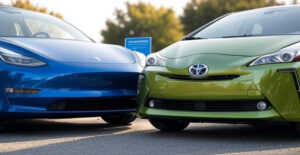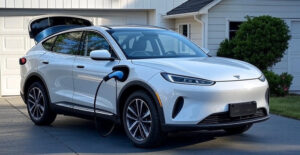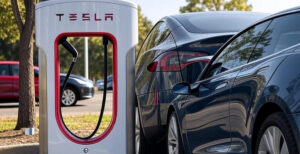Alright, so you finally got yourself an electric car. Welcome to the club! No more gas station smell on your hands or sudden $80 fill-ups when you’d rather spend that money on tacos. But now you’re probably wondering — how do I charge my EV at home without making my electric bill look like a small mortgage payment?
Charging at home can be dirt cheap… or it can be a sneaky wallet drainer if you don’t plan it right. In this friendly deep-dive, we’ll break down exactly how to charge your EV at home without breaking the bank. We’ll talk real costs, smart charging setups, secret hacks your utility company doesn’t want you to know, and a few “rookie mistakes” you really wanna dodge. Plus, I’ll share some real-life examples from other EV drivers, ‘cause this ain’t some boring textbook.
Stick with me — by the end, you’ll be the chill genius who plugs in overnight, saves money, and laughs at the gas pump every time you drive past it.
Why Home Charging is the Real MVP
Let’s get the obvious outta the way: charging your EV at home is usually cheaper and more convenient than public chargers.
You don’t wanna be the person who’s stuck at a shopping mall parking lot at midnight because the only fast charger was busy or broken. Plugging in at home is basically like having your own personal gas station in your garage or driveway — minus the stinky fumes and overpriced beef jerky.
Perks of charging at home:
✅ Plug in while you sleep — wake up with a “full tank.”
✅ Pay residential electricity rates instead of markup at public stations.
✅ Less waiting in line.
✅ Longer battery life (slower home charging is gentler on batteries).
✅ Makes you feel like Tony Stark with your futuristic setup.
What Home Charging Actually Costs
Here’s where people mess up — they assume plugging in is free or that it’ll cost a fortune. The truth’s somewhere in the middle.
1. The Basic Math
Let’s say you drive 1,000 miles a month.
Most EVs average about 3-4 miles per kWh.
So you’ll need roughly 250-330 kWh monthly to fuel your car.
If your local electricity rate is $0.12 per kWh, that’s about $30-$40 a month to “fill up.” That’s like two fancy coffees and a bagel.
BUT… if you live in California where rates are more like $0.30 per kWh, your cost jumps closer to $90. That’s still cheaper than gas for most people, but it can sting.
2. The Real Sneaky Costs
✅ Installation fees: Adding a Level 2 charger can cost anywhere from $500 to $2,000 for parts and labor. (More on that in a sec.)
✅ Peak rates: Charging during expensive “peak” hours can double or triple your costs.
✅ Home upgrades: Some older homes might need an electrical panel upgrade — that’s big bucks if your wiring is ancient.
Level 1 vs. Level 2: What’s the Deal?
Level 1 (Standard Wall Outlet)
Pros:
- Free to use if you’ve got an outlet.
- No installation cost.
- No brainwork — just plug in.
Cons:
- So slow. Adds about 3-5 miles per hour.
- Good for plug-in hybrids or people with short commutes.
- Takes literal days to fully charge a big battery from empty.
Level 2 (240V Outlet)
Pros:
- Sweet spot for most EV owners.
- Adds about 25-40 miles per hour.
- Fully charges overnight — no worries.
- More efficient and cheaper long-term than public charging.
Cons:
- Gotta buy a charger ($300-$700 average).
- Might need an electrician to run a 240V line ($500-$2,000).
If you’ve got a garage or driveway, Level 2 is the best bang for your buck. It’s like going from dial-up internet to fiber optics overnight.
How to Install a Home Charger (Without Crying)
Alright, let’s tackle the part that freaks people out: installation. Don’t stress — it’s easier than you think if you plan ahead.
- Check your breaker panel. Got an open 240V slot? You’re golden.
- Hire a licensed electrician. Don’t DIY unless you like sparks.
- Shop for your charger smart. Some brands qualify for tax credits or rebates.
- Mount it near your parking spot. Longer cords cost more and look messy.
- Consider smart chargers. These can adjust charging times automatically to save you cash.
💡 Pro Tip: Ask your local utility if they’ll help pay. Lots offer rebates for EV charger installs — sometimes up to $1,000 off.
How to Slash Your Charging Costs: Real-World Hacks
1. Charge at Off-Peak Times
Most utilities have cheaper rates late at night. Plug in after 9 p.m. and you’ll probably pay half as much as you would at 5 p.m.
Some smart chargers do this automatically — they’ll wait ‘til rates drop, then fill ‘er up.
2. Use Solar If You’ve Got It
If your roof’s rockin’ solar panels, congrats — you’re basically driving for free. Charging midday when the sun’s blasting is the dream.
No panels yet? Look into state or federal credits. Solar + EV = match made in savings heaven.
3. Monitor Your Usage
Most EVs have built-in apps to track charging. Get obsessed. See when you’re burning the most juice, and adjust.
I’ve got a buddy who realized his charger was topping off at peak hours because he forgot to set a schedule. Rookie move — cost him an extra $30/month until he fixed it.
4. Join Utility EV Programs
Some power companies run “EV rate plans.” If you let ‘em control your charger during peak grid loads, they’ll give you a discount. It’s like letting them borrow your car’s battery to balance the grid. Pretty sweet.
5. Don’t Always Aim for 100%
Topping up to 100% every time can stress your battery. For daily city driving, 80% is plenty and extends battery life. Plus, it charges faster up to 80%.

Real Story: How Much I Pay to Charge at Home
Meet Kevin from Denver. He drives a Tesla Model Y about 900 miles a month. He charges overnight with a Level 2 charger and pays about $0.10/kWh on an EV rate plan.
His total? $35/month for “fuel.” His neighbor with a pickup truck? Pays $300 a month on gas. Kevin brags about it constantly.
Rookie Mistakes to Avoid
❌ Charging during peak hours by accident.
❌ Not checking your home’s electrical panel first.
❌ Skipping rebates — free money’s free money.
❌ Going cheap on an installer — safety first.
❌ Topping off to 100% daily for no reason.
Q&A: Your EV Home Charging Questions, Answered
1. Can I plug my EV into a regular wall outlet?
Yup — that’s Level 1 charging. It’s super slow but works in a pinch.
2. How much does a Level 2 charger really cost?
Plan for $500-$700 for the unit, plus $500-$2,000 for installation.
3. Does charging at home ruin my battery?
Nope — slow, steady home charging is better for battery health than constant fast charging.
4. What’s the cheapest time to charge?
Usually overnight, but check your utility’s time-of-use plan.
5. Can I install a charger myself?
Not unless you’re a licensed electrician. Seriously — don’t.
6. What if I rent an apartment?
Check with your landlord. Some places install shared chargers, or you can use public stations nearby.
7. How long will my EV battery last?
Most last 8-12 years with normal use. Home charging helps them live longer.
8. Is solar worth it for EV owners?
Big yes — you’re basically driving on sunshine.
9. Do smart chargers really save money?
They can! Scheduling and load balancing cuts peak costs.
10. Do I need a special permit?
Sometimes, depending on local codes. Your electrician will know.
11. How fast is Level 2 charging?
Roughly 25-40 miles per hour, so you’re fully topped off by morning.
12. Is it safe to charge in the rain?
Totally. Modern chargers are designed to handle all weather.









